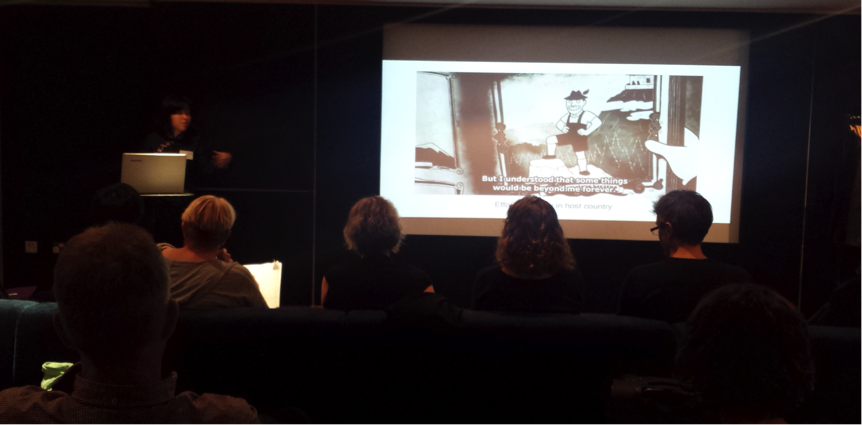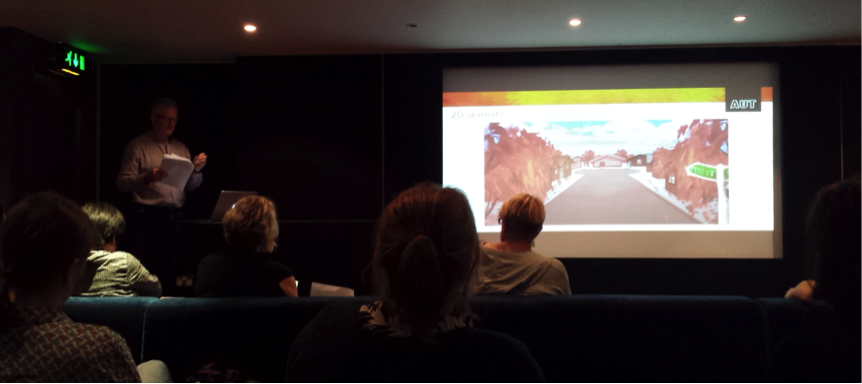Following the success of the first ‘Animation and Public Engagement Symposium’ (APES), which ran in association with the Bradford Animation Festival in 2014, APES 2015 touched down at the Tyneside Cinema in Newcastle for this year’s installment. Coordinated by Society for Animation Studies members Melanie Hani and Paul Wells from Loughborough University’s Animation Academy, the event sought to bring together participants from various backgrounds – members of the public, animators, and scholars – to reflect more deeply on the subject of public engagement.
Public engagement should be understood as a dynamic, two-way exchange, and Wells highlighted this equation in his opening speech, reminding those in attendance that animation can be a profoundly powerful tool to explore stories and empower individuals positioned on the edges of society. The challenges were clearly established: how we, as practitioners, can best capture and represent the world around us; and how we, as scholars, can best engage with the public to share our work in meaningful ways. The potency of animation to communicate hard-hitting messages in universal and accessible ways was highlighted early in the day, with the screening of Lina and May Ghaibeh’s pixilation animation, The Wind (2015), which attempts to offer an insight into the refugee experience.
Throughout the day participants were treated to a range of presentations, with speakers coming from a diverse array of backgrounds:
9.15am – 9.30am: Paul Wells
Welcome
9.30am – 10.00am: Melanie Hani and Nor Hazlen binti Kamaruddin
Cultural Rivers: The use of ‘Static Animation’ and ‘Axiom Documentary’ film making processes to identify issues relating to children who are first generational immigrants in the UK
10.00am -10.30: John Piper
Animating Health Processes – Enabling effective disease management through visual story-telling
10.30am – 11.00am: Qing Sheng Ang
Infusing local culture in Singaporean Animation – Developing a framework of cultural specifics from a study of contemporary cinema in Singapore
11.00am – 11.30am: Susan Young
Bearing Witness: Autobiographical Animation and the Metabolism of Trauma
12.30pm – 1.00pm: ChunNing Guo
Exploration of Memories Through Animated Documentary
1.00pm – 1.30pm: Birgitta Hosea and Graham Barton
Mindfulness and Animation
1.30pm – 2.00pm: Miriam Harris
Political Activism in Motion: The animated infographics of Patrick Clair
2.00pm – 2.30pm: Fanny Bratahalim
Diasporic Identities and Animation
4.00pm – 4.30pm: Sophie Burrows
Levelling Engagement through Stop Motion
4.30pm – 5.00pm: Ellie Land
Addressing Women’s Perspective in Health Animations
While it is not possible to describe every paper here, some selective detail might be of interest to readers.
Hani and Karmaruddin opened the day with a discussion of their use of Hani’s ‘Good Hearts Model’ of animation-based therapy. At its core, the ‘Good Hearts Model’ seeks to promote autonomy and the voice of the individual through animation exercises, which, as Hani noted, “allows for the silent hidden voice to be heard”. The presentation made clear that this model of therapy has found particular purchase with marginalised groups, helping first generation immigrants to tell their stories through animation.
Piper, from AUT University, Auckland (New Zealand), gave a paper entitled ‘Animating Health Processes – Enabling effective disease management through visual story-telling’ (Img. 1). This paper detailed a project that he is working on with his students, which seeks to animate a suburban street, via the creation of a comprehensive library of assets, so that episodes of animation can be created on a rolling basis, across student year groups. Each episode in this series will focus, in turn, on a different resident of the animated street, thereby bringing a different disease into focus.
Several speakers presented work on overlapping themes – with the concept of mindfulness underpinning the papers by Susan Young (‘Bearing Witness: Autobiographical animation and he metabolism of trauma’), ChunNing Guo (‘Exploration of Memories Through Animated Documentary’), and the co-paper from Birgitta Hosea and Graham Barton (‘Mindfulness and animation’). It is likely that this subject struck other attendees as an area where animation has rich potential to facilitate wider public good.
Throughout the day the subject of diasporic identity repeatedly surfaced, frequently in tandem with the realisation that animation is a well-suited medium to explore this subject given its metamorphic and unbounded potential to represent this liminal condition of being (Img. 2). Furthermore, it was pleasing to note that the audience in attendance was diverse, with speakers having travelled from the Far East, mainland Europe, and the southern hemisphere. Such rich diversity marked a welcome and refreshing change from the average UK media conference experience, where the audience is overwhelmingly Western, white, and almost exclusively Anglophone.
If APES 2016 is able to continue the excellent work of this year’s event, promoting diverse, public engagement then it is surely an event to mark on your calendars when the date is confirmed.

Image 2 – Fanny Bratahalim (speaker) used Persepolis (Satrapi and Paronnaud, 2007) as an example of a film that captures important qualities of diasporic experience, including the challenge of ‘trying to belong’.
Dr Chris Pallant is a Senior Lecturer in Film Studies at Canterbury Christ Church University. He is the author of Demystifying Disney: A History of Disney Feature Animation (2011), co-author of Storyboarding: A Critical History (2015) and editor of Animated Landscapes: History, Form and Function (2015). Chris has also published in book chapter and journal form on a range of topics, including Disney animation, the ‘cartoonism’ of Quentin Tarantino’s live-action films, performance capture technology, the animated landscape of New York City, and the work of Rockstar Games. Individuals interested in pursuing doctoral study in subject areas related to those listed above should contact Chris directly: chris.pallant@canterbury.ac.uk
In 2015, Chris organised the Society for Animation Studies annual conference in Canterbury, and currently serves as the Society’s Vice-President.
Twitter: @cjpallant.

